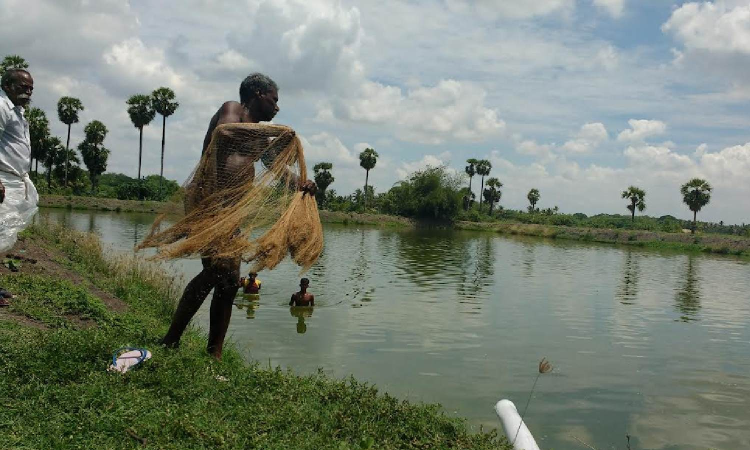High potential for inland aquafarming visible in TN
Owing to the good income, the fish farming practice has gained momentum across the Delta districts as the farmers, by and large, have opted for the integrated farming system in a bid to boost additional revenue apart from just relying upon crop cultivation

Inland aquafarming in TN
TIRUCHY: Being one of the vast inland fishery resources of the country with around 4 lakh ha in the form of ponds, tanks, rivers, reservoirs and brackish water, Tamil Nadu boasts of an annual production of 2.32 lakh-MT.
The aqua farmers of the state, particularly from the Delta region, urge the government to increase fish seed production and provide a subsidy to boost the livelihood of more than 3 lakh people.
Tamil Nadu has several long seasonal and short seasonal irrigation tanks and ponds suitable for the capture and culture of fish varieties. Apart from this, around 56,000 ha of brackish water area in the form of estuaries, backwaters and creeks are available for the potential aquafarming activities.
Besides these waterbodies, a total of around 7,400 km of rivers and canals offer good scope for fisheries development, and the State also has resources for cold water fisheries.
“The state government is committed to strengthening the infrastructure facilities for fish seed rearing and production, partnering with private firms and thus the production has achieved 2.32 lakh MT valued at Rs 6,279 crore,” a senior official from the Tamil Nadu fisheries department said.
Owing to the good income, the inland fish farming practice has been gaining momentum across the Delta districts as the farmers, by and large, are approaching the integrated farming system in a bid to boost additional revenue apart from just relying upon the crop cultivation.
Several fish species, namely Murrel fish (viral meen) Rohu, Catla, Mrigal, Common carp, and Grass carp (vernacular name: Kendai) are being cultured in the freshwater ponds across the region, particularly in Tiruchy, Thanjavur, Tiruvarur, Mayiladuthurai, Nagapattinam and Pudukkottai.
The Delta region contributes 35 per cent of total inland fish production.
Since agriculture has become a tough pursuit with nature failing the farmers frequently, the agriculturist here said that farmers and also non-farmers are now into the business of inland aquafarming practice to boost their fortune.
Though there are more than 33 varieties of consumable fresh water fish available in Tamil Nadu, the farmers prefer a few common varieties which are more lucrative.
Government is also promoting farming of fast-growing fish varieties through intensive fish culture techniques like Cage culture, Biofloc system and Recirculatory Aquaculture System.
“We are purchasing the fish seeds from government-run hatcheries in Thanjavur and Salem districts. We rear them till they attain 700 grams in weight, which would take a minimum of one year. Only natural foods such as rice bran (Thavidu), raw rice (Pachai Arisi), groundnut cake (Kadalai Punnakku) are fed to the fish in our ponds. Very much attention is required to spot the changes in the pond and to act subsequently,” R Fredrick Nixon, aquafarmer from Mettukudi village near Lalgudi in Tiruchy said.
Fredrick Nixon cultivates 200 to 300kg of fish at a time and around one tonne a year.
“I get an additional income of Rs 35,000 per yield. Apart from the local sales, we also send them to the markets in and around Tiruchy. It is a recurring income for at least seven years,” he said.
He also said that the government is providing a 40 per cent subsidy for aqua farming that includes infrastructure development.
“Though the amount we spent on infrastructure on the aqua farming is a one-time investment, the periodical maintenance needs to be undertaken for the quality cultivation. So the government should provide exclusive schemes to develop the inland fish farming,” he added.
Harvesting on basis of
market requirement
According to the officials, the Indian major carps on average attain hardly 1kg in size in a year, while Chinese carps reach over 2kg or so.
This kind of differential growth complicates the final harvesting programme, and hence, in such areas, partial harvesting of marketable-size fish is carried out.
The market price of fish is directly related to its size. This factor should also be considered before deciding on the harvesting programme.
The possibility of partial harvesting very much depends on the availability of fingerlings of the desired carp species. In such cases, the fish which reaches marketable size is harvested, and the stock needs to be replenished.
Usually, fish over 500g are harvested every 3–4 months, with simultaneous stocking with fingerlings.
Such a partial harvesting programme is synchronised with peak market demands depending on seasons, festivals, etc.
INLAND FISHING NOTES
62,015 ha: Reservoirs
56,ooo ha: Brackish water area
2.67 lakh-ha: Other waterbodies
3.85 lakh-ha: Total area used for inland fisheries
PRODUCTION
District Quantity (in tonne) Contribution in State (in per cent)
Tiruchy 873 0.38
Karur 552 0.24
Perambalur 477 0.21
Ariyalur 628 0.27
Pudukkottai 4,213 1.82
Thanjavur 46,157 19.90
Tiruvarur 10,570 4.56
Mayiladuthurai 12,328 5.32
Nagapattinam 3,597 1.55
2.32 lakh-MT: Produced in state annually
Rs 6,279 crore: Total value
2.36 lakh: Total fisher population



